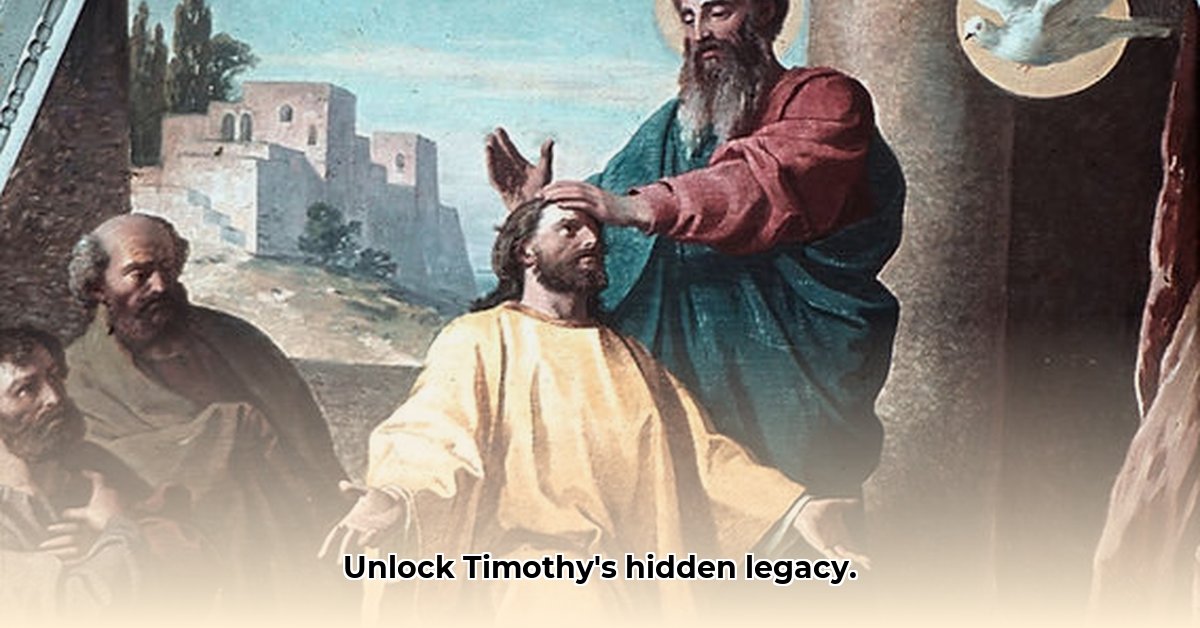Have you ever heard of Saint Timothy? He was a significant figure in the early days of Christianity, serving as a close friend and companion to the Apostle Paul. This article explores his life, his influence, and the reasons his story remains relevant today, spotlighting his journey from Paul’s protégé to a church leader. We will delve into the letters attributed to Paul and examine the lasting impact of Timothy’s life and death, providing a detailed look at this pivotal figure in Christian history. For another example of a significant early Christian figure, see more about Saint Anthony.
Saint Timothy: Bridging Cultures and Spreading Faith
Saint Timothy’s life is a compelling story of a young man with a unique blend of cultures – born to a Greek father and a Jewish mother in the first century in Lystra, a city in modern-day Turkey. This cultural intersection was crucial in making the new faith accessible to a broader audience within the Roman province of Galatia. His connection with the Apostle Paul, a central figure in early Christianity, profoundly shaped his life. This master-apprentice relationship developed Timothy’s leadership style, offering essential lessons relevant even today. Timothy’s mother, Eunice, and grandmother, Lois, are noted in the Bible for their strong faith.
The Mystery of the Pauline Letters: Authorship and Impact on Early Christian Practices
Understanding Timothy involves examining the letters attributed to Paul, known as the Pastoral Epistles (1 Timothy, 2 Timothy, and Titus), which offer profound insights into early Christian practices and beliefs. The authorship of these letters has been debated for centuries. Some scholars argue that Paul wrote them, citing consistent writing styles and theological themes with his other works. Others suggest different authors, pointing to potential inconsistencies in language or historical details. Regardless of the author, these writings significantly shaped early Christianity, providing practical advice on church organization, pastoral duties, and navigating challenges of faith—essentially, early Christian “how-to” manuals. But why does the authorship dispute matter? It influences our interpretation of the letters and their impact on the formative years of the Christian church, especially concerning the establishment of doctrine and leadership roles.
Spreading the Word: Saint Timothy’s Missionary Adventures and Early Christian Expansion
Timothy was not just a disciple; he actively contributed to the expansion of Christianity, traveling extensively to plant new churches and strengthen existing ones. He accompanied Paul on his second and third missionary journeys, visiting places such as Philippi, Thessalonica, and Berea. He courageously ventured across challenging terrains, faced unfamiliar languages, navigated cultural differences, and encountered potentially hostile crowds. Spreading the Gospel required immense courage and dedication in those times. What specific obstacles did Timothy face? Historical accounts and letters suggest a combination of practical struggles, such as limited resources, vast distances, and physical dangers, coupled with the emotional burden of sharing a faith perceived as a threat. What qualities enabled Timothy to inspire and nurture these nascent congregations? His leadership must have been both strong and compassionate in fostering such faith communities. He understood Jewish customs through his mother and could communicate effectively with Gentiles due to his Greek heritage.
The End of a Life, the Beginning of a Legacy of Faith
The details surrounding Timothy’s death remain somewhat mysterious, with accounts suggesting stoning or beating as possible causes in Ephesus (modern-day Turkey). Tradition holds that he was killed for opposing the worship of the goddess Artemis (Diana). The exact date is also uncertain, generally believed to be around 97 AD. Despite these uncertainties, Timothy’s death for his faith solidified his status as a martyr in Christian tradition. Across centuries and denominations, he is revered as a symbol of unwavering faith and courage. This martyrdom transcends the mere act of dying; it embodies the strength of belief and the willingness to stand firm in one’s convictions, even when facing death. How does his death resonate with Christians today? It inspires steadfastness in faith, even amidst adversity.
Lessons from a Life Well-Lived: Saint Timothy’s Enduring Influence
Timothy’s story provides timeless lessons through his multicultural background, blended Greek and Jewish heritage, demonstrating early Christianity’s inclusive approach to diverse communities. This inclusiveness extended beyond mere tolerance, reflecting a deliberate effort to integrate various peoples. His relationship with Paul highlights the profound impact of mentorship, emphasizing the importance of spiritual guidance and leadership development. His missionary work underscores the dedication, sacrifice, and bravery required to spread the Gospel. His martyrdom serves as a powerful symbol of faith prevailing under the harshest conditions. How can we apply these lessons to our lives? Seeking mentors, fostering inclusivity, and remaining faithful when facing challenges allows us to carry forward Timothy’s legacy.
Saint Timothy’s Lasting Impact: A Summary of Faith and Courage
| Aspect | Key Significance | How We Can Apply This Today |
|---|---|---|
| Multicultural Heritage | Demonstrated early Christianity’s acceptance of diverse cultural backgrounds. | Embrace diversity within faith communities. |
| Mentorship with Paul | Highlighted the crucial role of guidance in faith leadership. | Seek mentors; invest in nurturing future leaders. |
| Missionary Endeavors | Demonstrated dedication in spreading the Gospel to various groups. | Support missionary efforts and reach out to underserved populations. |
| Martyrdom as a Legacy | Emphasized the power of faith despite severe adversity. | Inspire perseverance in the face of life’s tests. |
| Authorship Debate (Pastoral Epistles) | Explored early Christian beliefs and practices. | Encourage critical engagement with and study of scriptural resources. |
Saint Timothy’s life unfolds as a compelling narrative of faith, perseverance, and lasting influence, challenging and inspiring Christians to live out their beliefs with courage and trust in God’s grace. His legacy serves as a testament to the transformative power of faith in the Christian journey.
How Did Saint Timothy’s Mixed Heritage Impact Early Christianity?
Key Takeaways:
- Timothy’s mixed Greco-Jewish background enabled him to bridge cultural divides within the early Church.
- This unique perspective facilitated the Gospel’s spread among diverse populations.
- His experiences shaped his ministry, demonstrating adaptability and inclusivity.
- The debate surrounding the authorship of the Pastoral Epistles impacts our understanding of Timothy’s role.
- Timothy’s life exemplifies the power of mentorship and faith in challenging times.
A Bridge Between Worlds: Timothy’s Greco-Jewish Identity
Saint Timothy, a close companion and associate of Paul, held a unique position in early Christianity. His heritage—a blend of Greek and Jewish cultures—profoundly impacted his ministry and the spread of the Gospel. How did this mixed heritage shape his interactions with diverse communities? How did it influence Paul’s mission strategies?
Timothy’s mother, Eunice, and grandmother, Lois, were devout Jewish believers, instilling in him a strong foundation in Jewish faith and tradition. This foundation can be found in 2 Timothy 1:5. However, his father was Greek, exposing him to a different cultural context. This dual inheritance equipped him with cultural fluency and empathy unlike many of his contemporaries.
Navigating Cultural Tensions: Fostering Understanding and Reconciliation
The early Church faced internal tensions between Jewish and Gentile believers. How did Saint Timothy’s mixed heritage impact early Christianity? His background enabled him to be a bridge between these groups. He could relate to both cultural perspectives, fostering understanding and facilitating reconciliation. His acceptance by both communities highlights the early Church’s capacity for inclusivity. This doesn’t suggest perfect harmony, but Timothy’s role demonstrates the potential for inclusivity within the emerging Christian movement. He could navigate Jewish customs and traditions while also relating to the broader Greco-Roman world.
The Pastoral Epistles: A Source of Debate and Theological Insights
The Pastoral Epistles (1 and 2 Timothy, Titus), traditionally attributed to Paul, offer significant biographical details about Timothy’s ministry. However, their authorship remains a subject of academic discussion. If Paul authored these letters, they provide invaluable insights into Timothy’s leadership, his struggles, and his unwavering commitment to the faith. Regardless, the content reflects important issues faced by the early Church, such as maintaining doctrinal purity and fostering unity. These letters provide guidance on church leadership, combatting false teachings, and maintaining sound doctrine.
Scholarly debate continues regarding whether the letters accurately reflect Timothy’s life and ministry or were written to address specific theological or organizational challenges after Paul’s death. This debate doesn’t diminish the significance of exploring the potential impact of Timothy’s background on the messages conveyed in these texts. Some scholars argue that the language and style of the Pastoral Epistles differ from Paul’s other letters, suggesting a later author.
A Lasting Example: Faith, Mentorship, and Cross-Cultural Understanding
Timothy’s life stands as a testament to the importance of faith, mentorship, and cross-cultural understanding in the early Church. He wasn’t merely a passive recipient of Paul’s teachings but an active participant in shaping the trajectory of Christianity by actively spreading the gospel. His story illuminates how personal experiences can profoundly shape individual ministries and the direction of a nascent global movement. Timothy served as a role model for young believers and leaders in the early church.
Saint Timothy’s Missionary Journeys and Their Impact on Early Church Expansion
Key Takeaways:
- Timothy’s close relationship with Paul significantly shaped his life and ministry.
- His missionary journeys expanded Christianity’s reach across diverse communities.
- He played a vital role in establishing and strengthening early churches, solidifying his influence.
- Timothy’s legacy inspires leadership, doctrinal fidelity, and cross-cultural ministry.
- The authorship of the Pastoral Epistles remains a










